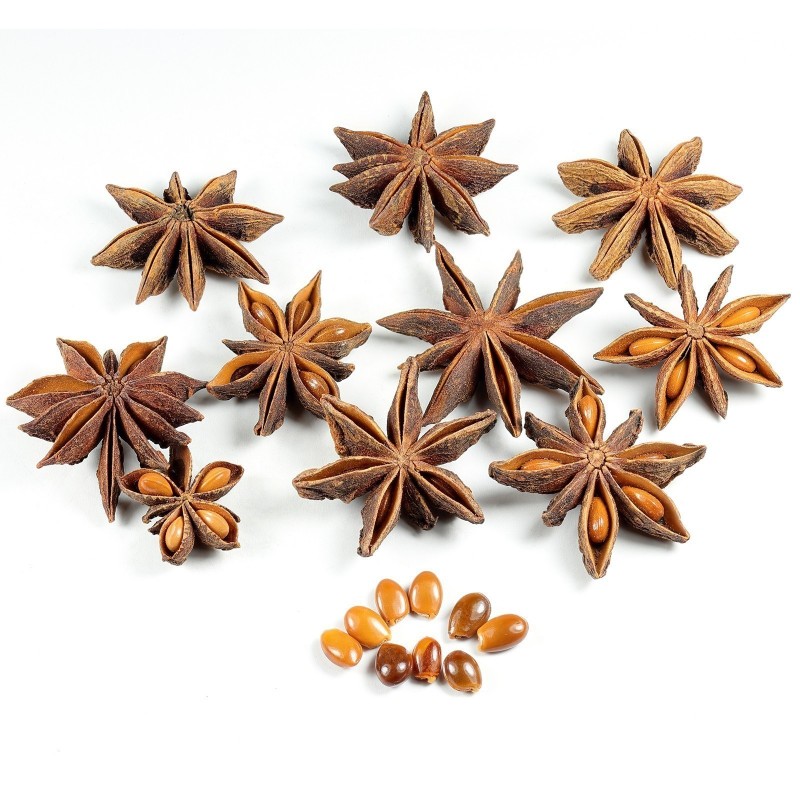








Illicium verum popularmente como anis estrelado,anis da China, anis da Sibéria, badiana ou funcho da China é uma planta originária da China e do Vietnã. É considerado uma especiaria de uso medicinal e culinário. Possui um aroma idêntico ao do anis pois contém o mesmo óleo, embora seja mais forte.
Há outra espécie próxima, originada do Japão, denominada de anis-estrelado japonês (Illicium anisatum, também conhecido como Illicium religiosum, Illicium japonicum), shikimmi ou skimmi. Está espécie é reconhecida cientificamente como altamente venenosa e é, por isso, imprópria para o consumo humano
A espécie Illicium verum possui 1 sinônimo reconhecidos atualmente.
É uma planta de 6 a 8 metros de altura, cultivada no sul da China, no Vietnã, Japão, Filipinas e ilhas do mar do Caribe, os frutos constituem em rosetas que depois de colhidas e maduras são desidratas ou submetidas à destilação para a extração de seu óleo volátil.
A flores são desde brancas até vermelhas, solitárias, os frutos têm o formato de estrela de cinco pontas, consistindo em 8 carpelos arranjados em torno de um centro, cada carpelo é rígido com o formato de barca contendo cada um uma semente marrom, ovoide e brilhante. Os carpelos são mais aromáticos do que as sementes.
Possui propriedades digestivas tendo sido usado contra intoxicações por frutos do mar. É conhecido também por suas propriedades antissépticas, antiinflamatórias, calmantes, digestivas e diuréticas. Na culinária, a estrela-de-anis é utilizada para produzir óleos essenciais e aromatizar bebidas alcoólicas, como a sambuca. É a partir desta planta que se produz o principal fármaco para tratamento da Gripe A, o Oseltamivir (nome comercial: Tamiflu).
É aromatizante usado em pães, bolos, peixes e frutos de mar, deve ser usado com cautela pois pode ser tóxico. Ingrediente essencial ao "pó de cinco especiarias", o anis-estrelado é usado na culinária chinesa em sopas, caldos, marinadas para carne de porco, pato e frango. Na cozinha vietnamita é cozido em caldos e no pho (sopa de macarrão e carne). Na Índia, o anis-estrelado é comumente usado para substituir o anis por ser mais barato.
É uma dos ingredientes do Chartreuse.
How to Grow Star Anise From Seeds
Star anise trees (Illicium verum) grow easily from seed. Star anise trees grow in U.S. Department of Agriculture plant hardiness zones 7 through 10 and do best with a soil pH between 4 and 6 that's rich in organic matter. They grow in either full sun or part shade.
Preparing and Planting Star Anise Seeds
Carefully preparing and planting the seeds will give the best chance of success. Or, store the seeds in moist sand in a sealed plastic bag or container in the refrigerator for up to a month.
Step 1
Pour seed-starting potting mix into 4- to 6-inch-diameter plastic pots. Fill them to 1 to 1 1/2 inches from the top. Moisten the mix with room-temperature water. Use pots that have drainage holes in them.
Step 2
Place the seeds into a bowl filled with water. Throw away any seeds that float to the surface. They are not viable. Plant only the seeds that sink to the bottom.
Step 3
Place two or three seeds per pot on top of the moistened potting mix, spaced evenly apart. Cover the seeds with a 1/4 to 1/2 inch of a moistened seed-starting mix. Firm it gently with your fingers to remove air pockets. Set plastic water or soda bottle with the bottom cut out over the seeds. Leave the screw caps on.
Step 4
Put the containers in bright, indirect light where temperatures stay around 70 degrees Fahrenheit. Moisten the potting mix using a spray bottle with room-temperature water if it begins to dry or set the containers in 1 to 2 inches of room-temperature water for an hour or two. The water will soak up into the germination mix through the holes in the bottoms of the containers.
Step 5
Remove the screw caps from the tops of the bottles after the seeds germinate. Remove the bottles a week later. The seeds should germinate in one to two months.
Step 6
Pot the star anise tree seedlings up in individual 6- to 8-inch pots when they are 3 to 4 inches tall. Use pots with drainage holes. Pot them up using peat-based potting soil. Set them in bright, indirect light and water them with room-temperature water when the top of the potting soil begins to dry.
Step 7
Grow the star anise plants in their containers for one year. Repot them into containers 1 inch larger when they become pot-bound or when you can see the roots through the drain holes in the bottom of the container. Set them outdoors during the day in the summer when there is no danger of frost and the weather is calm and pleasant. Put them in bright shade in an area that is protected from strong winds. Continue to water them when the top of the soil begins to dry.
Step 8
Plant them outdoors in their permanent positions the following spring after any danger of frost has passed. Begin to get them used to direct sunlight two weeks before planting. Start with an hour of direct morning sunlight and increase the duration by 30 minutes or so every two days. Water them when the top 2 inches of soil feel dry. Plant multiple trees 15 to 20 feet apart. Water them generously right after planting and continue to water them as often as necessary to keep the soil lightly moist.
Ficha informativa

 Reviews (0)
Reviews (0)